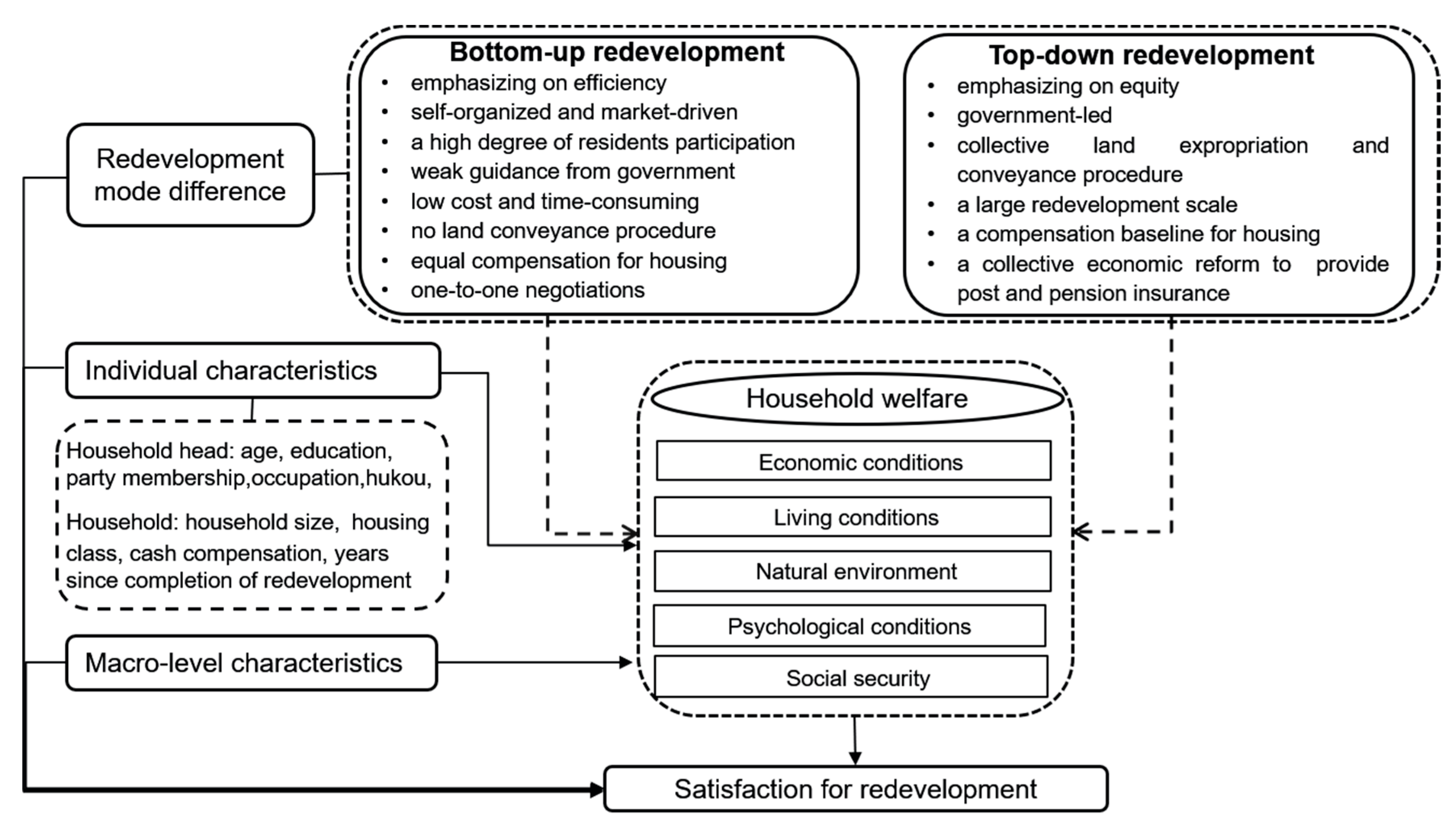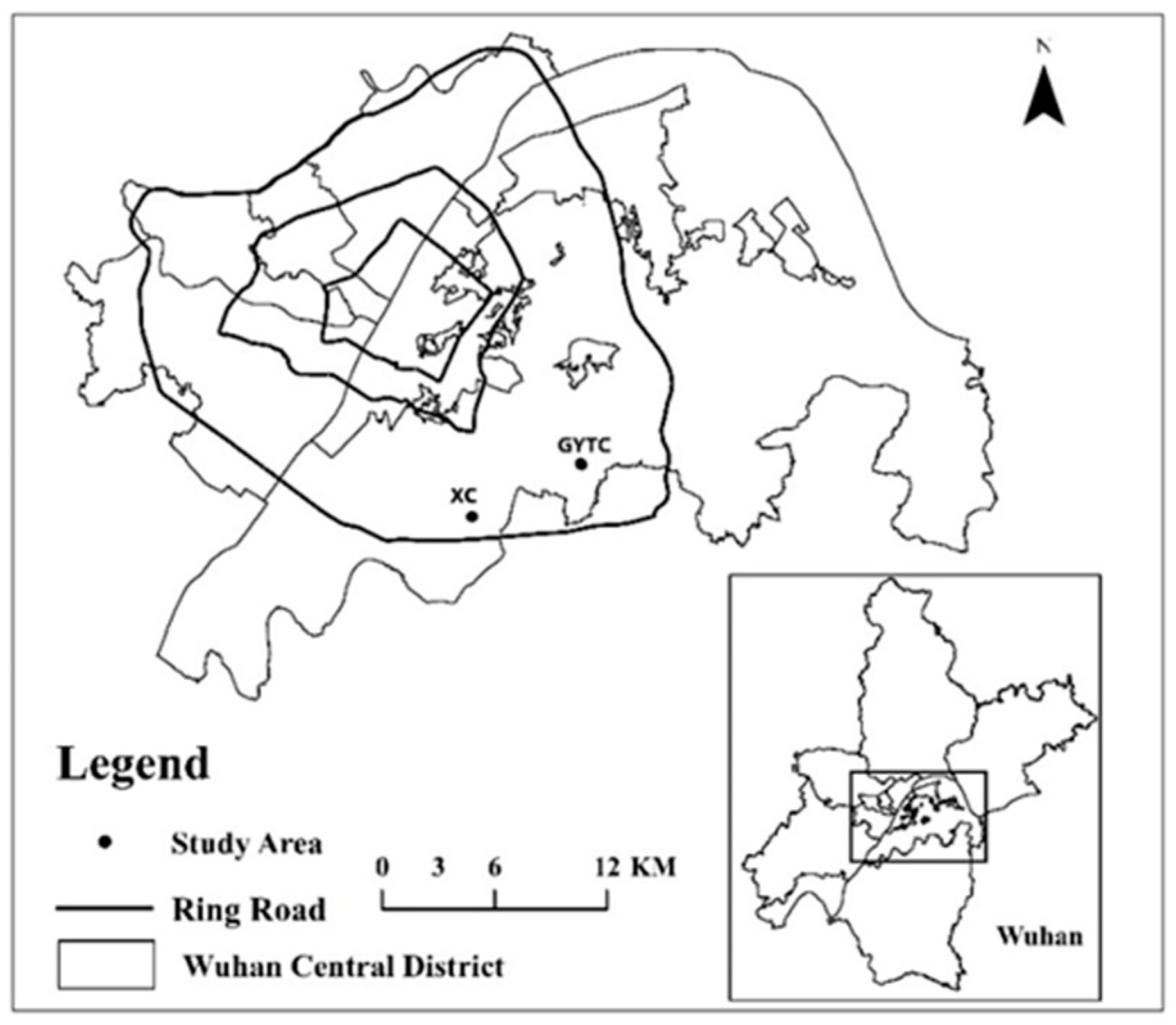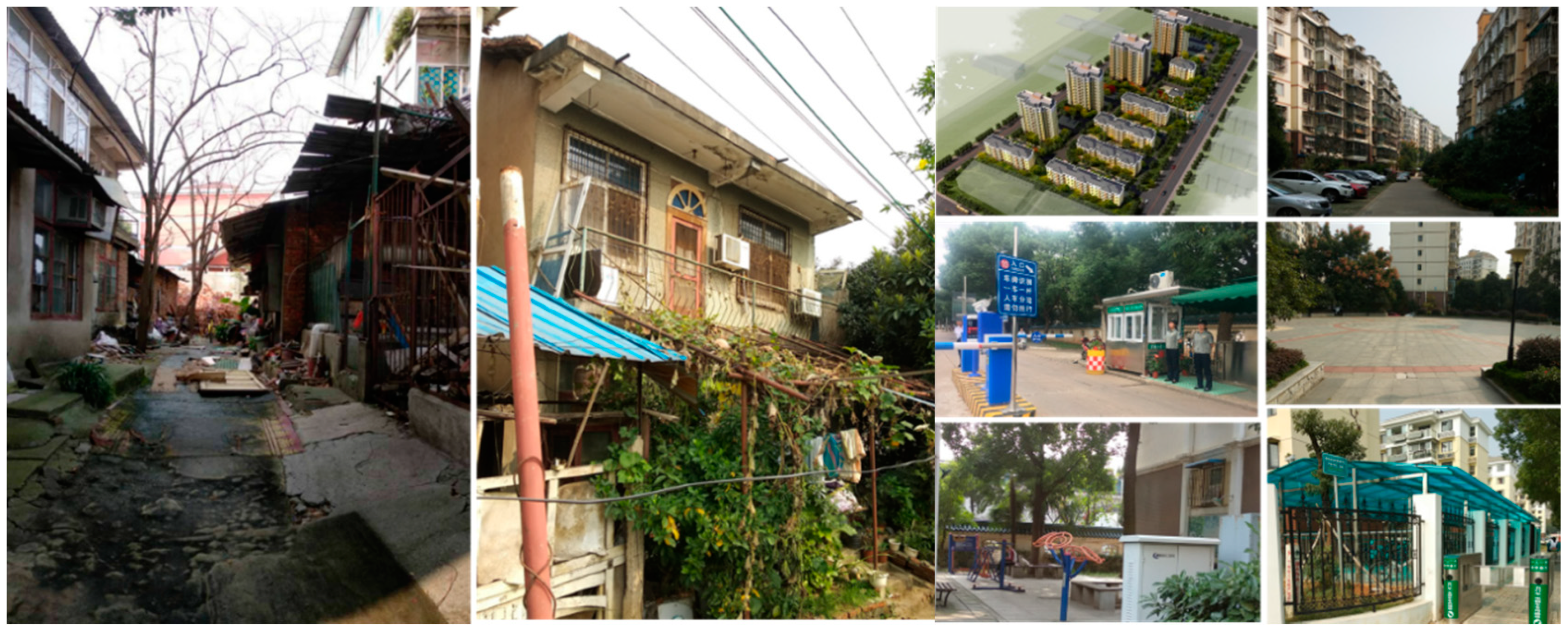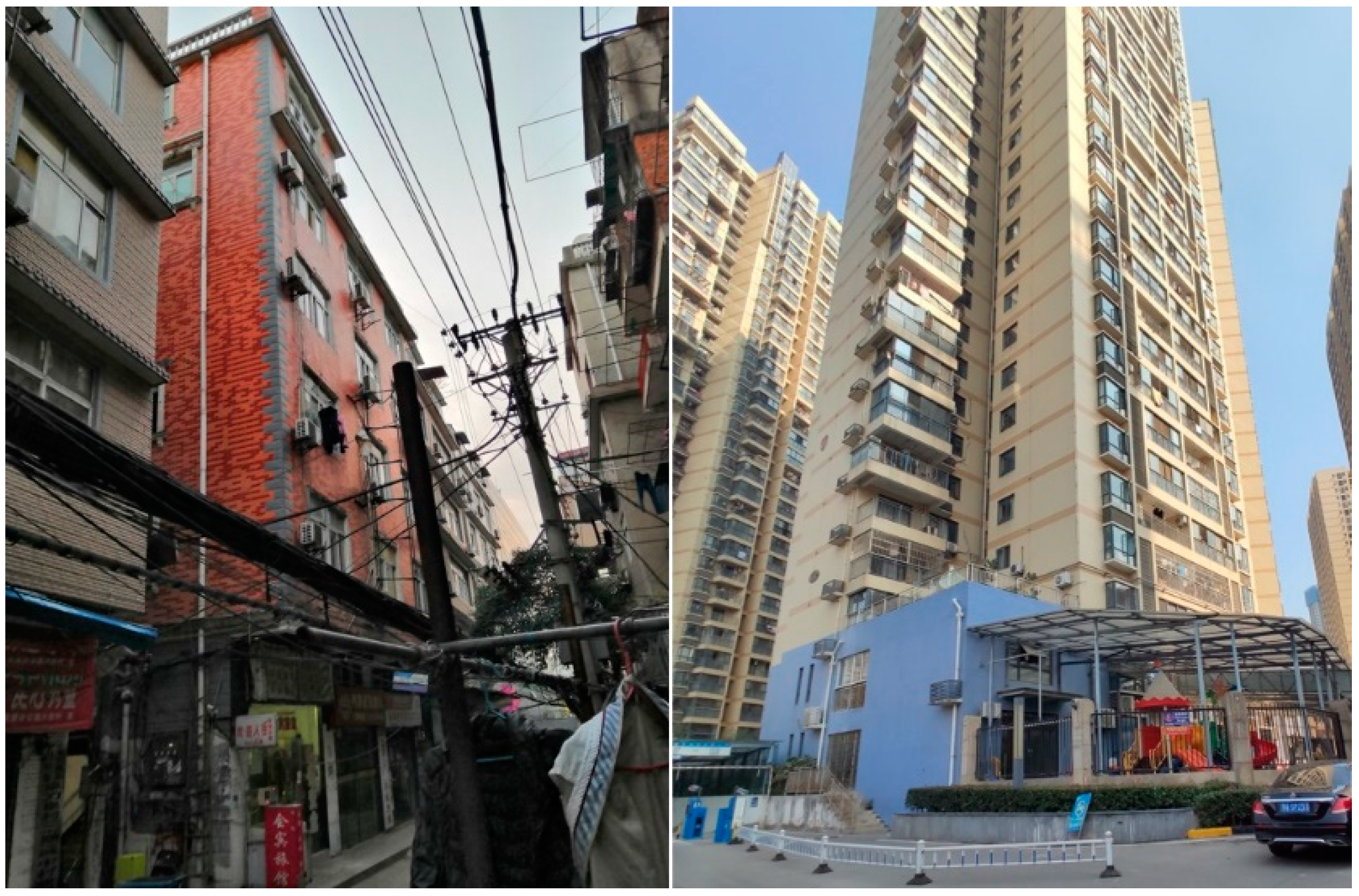5.1. Description Results of Welfare Change in Different Dimensions
Indicators involve the local weight and global weight due to the two-level index.
Table 4 lists the local weight and global weight of all indicators. Local weight is derived from judgments with respect to a single criterion that expresses the relative impact of the set of elements on an element in the level. Global weight is derived from multiplication by the weight of the criteria. “Economic conditions” has the largest weight of 0.297 in the first level of welfare. The largest weight, of housing property income to welfare, is consistent with the livelihood characteristics of villagers.
Table 5 lists the welfare changes in different dimensions. Almost all dimensions of welfare before and after the redevelopment in the two communities passed the connotation of the paired
t-test. The statistical description of the heterogeneous effects based on the difference-in-difference method passed the top 1% of the significance test. These findings show that there is significant difference in the welfare change of different dimensions in these two different modes.
For economic conditions with the largest weight, the change of economic indices after redevelopment in GYTC increased by 14.7%, whereas in XC, the economic welfare of residents decreased by 11.67%. Due to the changes in housing patterns, resettled households in XC had to close down businesses such as small hotels and restaurants to start a new job. Such dramatic transformation in livelihood increased expenses in commuting and property management, which resulted in a corresponding decline in economic conditions. There are two main reasons for the improvement in economic conditions of the residents in GYTC. On the one hand, there are idle houses to rent and an increasing income for residents, due to the improved environment and multiple resettlement apartments. On the other hand, residents receive a certain degree of share dividends every year as members of the economic joint-stock group. With the sustainable use of industrial land and the improving development of the reformed economy in Guanshan Village, each quinquagenarian holds 100,000 shares and receives a dividend of approximately CNY 5000 each year. Every young adult has 200,000 shares, with an annual dividend of approximately CNY 9000. The dividend has gradually become one of the major sources of income for resettled households. In conclusion, collective economic reform is the main reason for an increase in positive economic benefits being brought about in the top-down and government-led redevelopment mode.
As we know, the demolition of old houses and the construction of new houses in redevelopment probably brings direct changes in living conditions. Residents’ living conditions in XC improved significantly, with an increase of 51.73%. In contrast, there has been a slight decrease of 4.5% in GYTC. Most of the houses in XC before redevelopment were old structures, built in the 1980s and 1990s (
Figure 3). There are incomplete infrastructures and supporting facilities, due to the previous lack of proper planning. After redevelopment, most residents’ housing areas had increased slightly, due to the one-to-one negotiation which operates on the basis of an equal exchange for housing property. The effectiveness of public participation also ensures that housing conditions meet the humanized needs for living, through unified planning. At the same time, infrastructures such as water and electricity supply, and networks have been improved. Supporting facilities, such as parking spaces and fitness centers, have been provided, as well as property centers, supermarkets, and community medical service centers (
Figure 3). Therefore, living conditions in XC have been significantly improved, compared to the conditions before redevelopment. Similarly, there has been improvement in infrastructure and supporting facilities in GYTC since redevelopment. Public security has been improved in both communities. However, the housing area of most resettled residents has still decreased dramatically, due to the ceiling set in terms of compensation area. In addition, the government sold a large portion of the land to developers, who engaged in commercial development to obtain land revenue. These developers only left a small portion of land for the construction of resettlement houses, which has caused a high housing density and a high plot ratio, with more than 30 floors in most buildings (
Figure 4). In the survey, most respondents in GYTC complained about the unreasonable layout and the poor lighting of apartments. These shortcomings were caused by the lower public participation in redevelopment and land revenue.
In terms of the natural environment, the change rates of resettled households in XC and GYTC after redevelopment are 31.32% and −17.45%, respectively. The main reason for this significant difference lies in the fact that the bottom-up redevelopment scheme was jointly negotiated by villagers and the university. Not only did villagers pursue a comfortable living environment, but the university also aimed to improve the campus environment, because the promotion of ecological values can be transformed into comprehensive competitiveness for the university. Redevelopment of industrial land and development land in the top-down and government-led mode increased the commercial prosperity and traffic convenience of the community, but also brought some negative effects to the natural environment, such as noise and air pollution.
The psychological welfare of residents in XC improved slightly, whereas that of residents in GYTC was worse than before redevelopment. The changes in psychological indices show that trust in others and neighborhood relationships both declined after the implementation of these two projects. This negative effect was mainly caused by changes in living arrangements and lifestyles. After redevelopment, living in a closed multistory residential building can distort the previously harmonious neighborhood relationship, as well as the mutual trust relationship of resettled households that existed before redevelopment [
24]. These relationships need to be rebuilt and adapted to the point where they move from unfamiliarity to familiarity. The sense of community of local villagers in terms of household registration, lifestyle, psychology, etc. increased the social identity of individuals as urban residents in both scenarios. The main factor that contributes to the diversity of psychological conditions between these two modes is the significant difference in the sense of community belonging. This is directly caused by the different degrees of residents’ participation in redevelopment. Resettled households in the bottom-up and self-organized mode participated in the entire process of redevelopment and had a stronger sense of self-management and community belonging [
51]. However, the original system of rural grass-roots self-government was broken, and the governance and sense of belonging to the new community were not well established in top-down and government-led mode. Redevelopment modes may affect the welfare differences of resettled households through different forms of participation and differences in community governance.
The difference of social security before and after redevelopment passed the significance of the paired t-test in the top-down mode. In this mode, the government provided certain job positions, employment training, pension, and medical etc. Changes of social security in top-down mode are slightly better than that in the bottom-up mode. However, resettled households in the top-down before demolition have almost covered the endowment and medical insurance. Therefore, degree of welfare gains in social security in this mode is not high. In the bottom-up mode, a lack of the employment security measures meant that the slight increase in social security did not pass the paired t-test.
Changes in the comprehensive welfare after redevelopment also show opposite trends in these two modes. The comprehensive welfare of residents in XC improved significantly after redevelopment, from 0.3712 to 0.4462, representing an increase rate of 20.2%. However, the comprehensive welfare of residents in GYTC slightly declined, from 0.4459 to 0.4227, or a decrease rate of 5.2%.
5.2. Results of OLS Model for Welfare Change
The regression results of the factors that influenced differences in welfare change are shown in
Table 6. In terms of the characteristics of the household head, Party membership has a significantly positive impact on living conditions and comprehensive welfare, owing to Party members’ strong adaptability and high support for the redevelopment policy. With regard to household characteristics, housing class has a significantly negative impact on welfare, especially living conditions, due to the ceiling set for housing compensation. In addition, household size, age, education, and occupation all have an influence on different dimensions of welfare change to different degrees. Although most residents only choose the property exchange option because of the huge gap between housing value and monetary compensation, some residents still choose to receive a portion of the monetary compensation for housing decoration, investment, etc. The higher the monetary compensation is, the higher the level of living and psychological welfare will be. Therefore, monetary compensation has a positive impact on living conditions, psychological conditions, and comprehensive welfare. Moreover, results show that welfare in living conditions, natural environment and comprehensive welfare haven been gradually increasing over the time. In other words, with the adaptation to their new environment and new identity, the welfare of resettled household will be increased.
The influence of Mode on welfare change is consistent with the analysis of the results above. Specifically, the bottom-up and self-organized redevelopment mode has more positive effects on living conditions, natural environment, and psychological conditions but more negative effects on economic conditions and social security, compared to the top-down mode. The overall effect on welfare is positive in this bottom-up mode. More importantly, the difference of redevelopment modes has a more obvious impact on welfare than that of individuals and household characteristics.
5.3. Mediating Effect of Welfare Change on Satisfaction with the Redevelopment
Stakeholders’ satisfaction with the redevelopment policy reflects the implementation effect of a public policy, and further affects the future implementation and improvement of that policy. The results of the survey on the comprehensive satisfaction with urban village redevelopment showed that the average satisfaction in XC and GYTC are 3.26 and 2.83, respectively. Satisfaction with the redevelopment of XC is significantly higher than that of GYTC. In order to increase the stability of the difference in satisfaction between the two modes, an independent t-test for satisfaction was conducted, and this passed the significance test of the top 1% level with a t-value of 4.288. Residents have played a valuable role in the determination and implementation plans of bottom-up redevelopment. As such, residents have been frequently organized to negotiate compensation plans for redevelopment, so as to achieve a win-win situation in multiple aspects. As a result, there is a higher satisfaction with the redevelopment in XC. However, the top-down redevelopment directly follows the compensation scheme and procedure formulated by the government, which seldomly accepts suggestions from the public in GYTC. The housing property values of most residents who had a high level of original housing area were severely diminished, due to the ceiling placed on housing compensation. Therefore, this policy for this top-down mode received the lower satisfaction rate.
The Sobel model is used to test the mediating effect of welfare changes in this study. With the control of other independent variables, the mediating variable passed the significance test.
Table 7 lists the results related to the impact of redevelopment modes on welfare change, and the impact of welfare change on residents’ satisfaction with urban village redevelopment. Both passed the significance test of the top 1% level. Compared with the traditional top-down mode, the bottom-up mode has a more positive role in increasing welfare; then, the increase in welfare improves the level of satisfaction. In other words, redevelopment in the bottom-up mode enhances the residents’ satisfaction through the improvement of welfare for villagers. The results of the mediating effect of welfare in different dimensions confirm that a bottom-up redevelopment obtains higher satisfaction, mainly through the improvement of the living welfare and psychological welfare of resettled residents.









